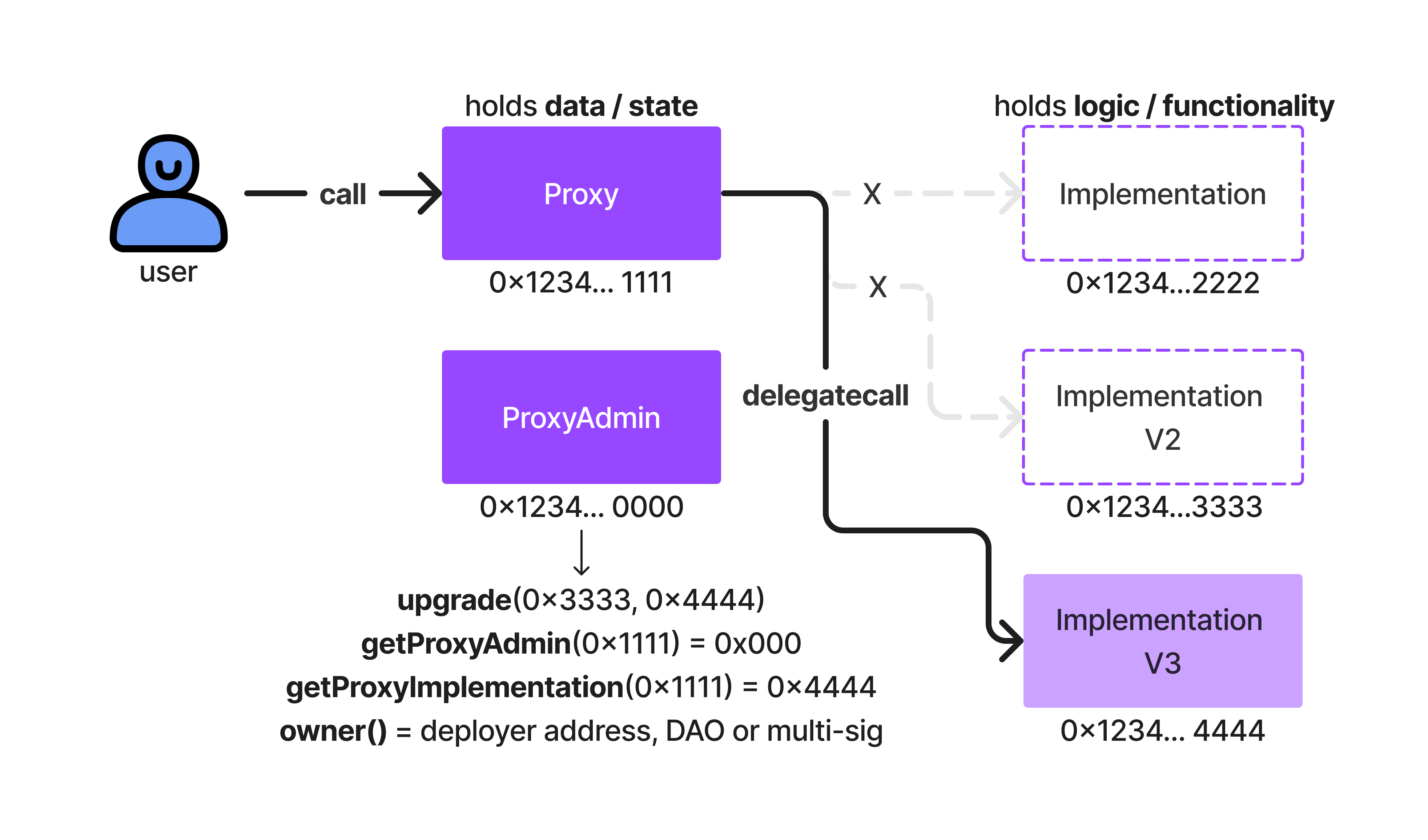What are upgradeable smart contracts?
Upgradeable smart contracts use three contracts: Proxy, Implementation, and ProxyAdmin. This pattern enables iterative releases and patching of source code.
Did you know smart contracts can be written to be upgradeable? That's right! If you intend it at deploy time, you can make it so that your smart contract is able to be "upgraded". Let's dig in...
Why Upgrade Smart Contracts?
By design, smart contracts are immutable. On the other hand, software quality heavily depends on the ability to upgrade and patch source code in order to produce iterative releases.
In short, if you want to make your smart-contract-based software be based on a more iterative approach, you can still do so and are not constrained by set-in-stone immutability. It is up to you to determine whether your dApp will require upgradeable software infrastructure!
How Do Upgradeable Smart Contracts Work?
Upgradeable smart contracts are a pattern composed of THREE contracts:
Proxycontract: The smart contract the user interacts with directly.- This contracts holds the contract state (ie, the important data is held here!).
- This is an EIP1967 standard proxy contract.
- This proxy contract is in charge of forwarding transactions to the implementation contract, the one containing the pure logic.
Implementationcontract: The smart contract that provides the skeleton logic and data.- This is where you instantiate your variables. Your proxy contract, via delegate calls into this one, will give them value!
ProxyAdmincontract: The contract linksProxyandImplementation.- This contract holds authority over
Proxyto upgrade the Proxy contract and thus link that proxy to a new implementation contract.
- This contract holds authority over
Check out the OpenZeppelin FAQs on Proxy, Implementation and ProxyAdmin contracts! 🔍
Visualization: Upgrading a Smart Contract from V2 to V3

The above diagram shows what is called the transparent proxy pattern. This pattern uses call, delegatecall and the three-contract design in order to achieve a super cool infrastructure. 💥
Here is a breakdown of the diagram flow, from the user's perspective:
- The user performs a
callinto theProxycontract - That
callhits thefallbackfunction of theProxycontract which is directly rigged todelegatecallinto theImplementationcontract address - In performing a
delegatecall, the context of theProxycontract is forwarded. This means that the storage of0x1234.1111will be directly affected by the logic of0x1234.4444(that's the whole point ofdelegatecall!) - The logic from
Implementationis performed on the state ofProxyand if the logic does not revert, the state is returned toProxywhich then returns a receipt to the original user - Transaction over! 🧾
Vending Machine Activity ➡️
In the next section, you will run through a guide that has you set up and deploy an upgradeable vending machine smart contract using two extremely useful tools:
BTW, Why Use That Hardhat Plugin?? 🔧
As is a common theme in this course, we are always looking to equip you with the latest and greatest tools to build quality smart contracts. The OpenZeppelin Hardhat Upgrades plugin serves to abstract a lot of the complexity of what we just discussed above away from us as developers so that we can focus on more specific solutions such as: do we want this contract to be upgradeable, yes or no? 👀 Thanks to the plugin, we can get up and running with upgradeable smart contracts in a flash and we'll learn how to do just that in the activity next section!
Can you start thinking of why a vending machine would be a good candidate to enable upgradeability on? 🤔 Let's go! 🥤
Learn More About Ethereum Development
Alchemy University offers free web3 development bootcamps that explain upgradable smart contracts and help developers master the fundamentals of web3 technology. Sign up for free, and start building today!
Updated almost 2 years ago
